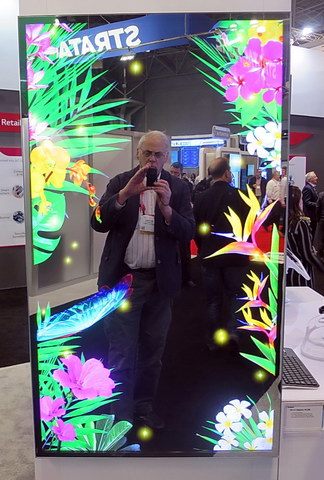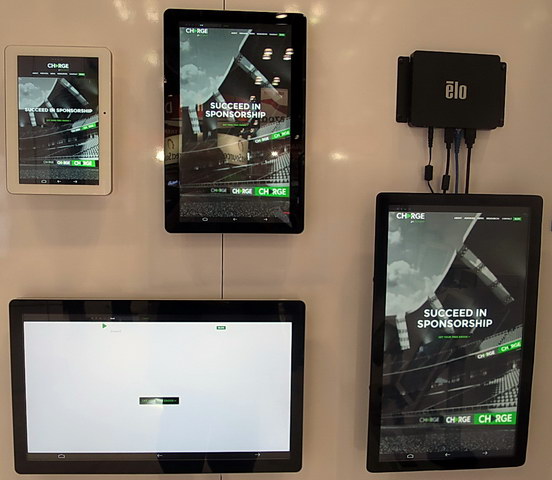 Samsung’s 55” mirror display put a frame around Meko’s Matt Brennesholtz while he took a selfie. (Credit: M. Brennesholtz)
Samsung’s 55” mirror display put a frame around Meko’s Matt Brennesholtz while he took a selfie. (Credit: M. Brennesholtz)
In addition to its mobile platforms, discussed elsewhere in this issue, Samsung also had one of its ML-55E mirror displays in their booth. This display can mix a mirrored image with a computer generated image. This display has 90% image transmission and 55% mirror reflectance. The mirror is embedded at the factory for easy installation in a retail store or for other applications.
 Elo’s new i-Series 2.0 Android displays. An Elo media player is shown at upper right. (Credit: M. Brennesholtz)
Elo’s new i-Series 2.0 Android displays. An Elo media player is shown at upper right. (Credit: M. Brennesholtz)
Elo was showing its new i-Series 2.0 touch screen all-in-one (AIO) digital signage systems at NRF. The new 2.0 members in the i-series are all Android 7.1, although the company still sells the original i-series units running both Android and Windows 10. Sizes for the new Android i-series units are 10,1” (16:10, 1280 x 800 @ 60Hz, 8-bit 400 cd/m²), 15.6” (16:9, 1920 x 1080 @ 60Hz, 6-bit, 300 cd/m²) and 22” (16:9, 1920 x 1080 @ 60Hz, 6-bit with Hi-FRC, 250 cd/m²). The Hi-FRC LCD drive technology in the 22” model is said to allow it to display as many colors as an 8-bit system. All the systems have a Qualcomm Snapdragon processor and 10 point PCAP touch screens. They also have the option of power-over-Ethernet (POE).
These commercial-grade units come with a two year warranty and are designed to survive the rigors of continuous public use. Retail applications include in-store interaction, point of sale, self service and wayfinding. Elo says they are also suitable for corporate and hospitality environments. The units are available in black or white.
A variety of options are available for the i-Series 2.0 systems, including a barcode scanner, a magnetic card reader, a payment terminal and a near-field communications (NFC) interface. These accessories support retail applications such as in-store price checkers, POS terminals, and endless aisle applications.
I also got a demonstration of the company’s Elo-View software from Elo representative and software guru, Dave Murphy. This is a cloud-based SaaS system that allows a central location to control display signage, regardless of the signage’s physical location. This software was being used to control the content shown on the all 70 or so the displays in the Elo NRF booth. Displays can be grouped, allowing all displays of one type to show the same content. The connection between Elo-View and the touch screen displays is not one-way. The displays can feed back to the software the touch data and the content seen by the display user. More grist for the analytics mill, especially if the display is camera equipped.
The content need not be pre-recorded and Elo-View can grant Internet access to individual displays or groups of displays. I challenged Murphy to grant the 70” touch screen signage display access to the Display Daily website. He did that and, using the display’s touch screen, I called up the pre-NRF Display Daily article I had written January 10th. In 30 seconds or so, there it was, for all the world to see, or at least anyone at NRF near the Elo booth. I used the image of me and the 70” Elo display in my post-NRF DD, published elsewhere in this issue.
 The Honeywell 1902G-BF wireless scanner
The Honeywell 1902G-BF wireless scanner
An interesting and recently introduced (April 2017) product Honeywell showed at the NRF was the Xenon 1902G-BF scanner. This is a wireless barcode scanner that can reliably read barcodes and report them to the host when it is up to 10M (33 feet) from its base. The really interesting thing is it is battery-free and said to be the first battery-free, wireless barcode scanner from any vendor. Instead of a battery, it uses a capacitor for power storage. A single charge on the capacitor is good for about 400 scans.
The use of a capacitor provides two advantages. First, the capacitor has a longer life than a typical battery – the specified 500,000 charge cycles would last about 5 years under frequent charge/discharge cycles compared to about 1.5 years for a battery. In this case “frequent” means 274 charge/discharge cycles per day or more than 100K scans/day. This five years corresponds to the expected service life of the scanner so the unit should never need any maintenance. Secondly, the capacitor can be recharged much faster than a battery.
Recharge time, when it is returned to its USB-connected base, is said to be between 30 seconds and 3 minutes, depending on the power available through the USB connection. 20 seconds on the base will give a completely discharged capacitor sufficient power for 20 scans, with any USB connection. A separate power connector to the base is not required but may be used if the USB connection has insufficient power and a fast recharge is needed by the retail application.
Absen 2.6mm pitch LED videowall at the Innovation Lab stage. (Credit: M. Brennesholtz)
All the talks on the Innovation Lab stage were presented on a Absen LED videowall with a 2.6mm pitch. In the image, the Absen screen is on the left, showing an image of the speakers on the right. Due to the high ambient light which included sunlight falling directly on the screen, it would have been impossible to use projection for these talks.

